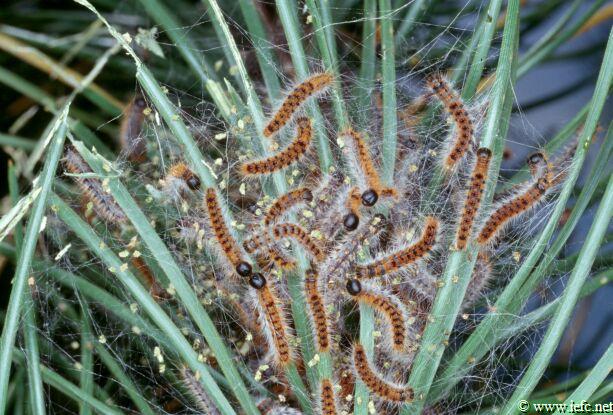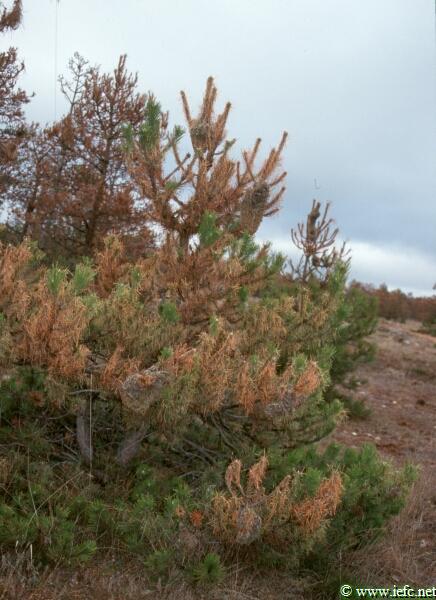Pine processionary moth
Thaumetopoea pityocampa (Hübner) (Lepidoptera, Thaumetopoeidae)
Host tree
All pine species (Pinus) and cedars (Cedrus). Plantations with Pinus radiata, P. nigra, P. canariensis and P. sylvestris are the most susceptible, P. pinaster and P. halepensis are the least.
Identification
- In late summer and early autumn, yellow-brownish needles at the shoot extremities (with small silky nests) (Photo 1).
- In late autumn and winter, silky nests at the end of the branches and defoliation (Photo 2 and 4).
- In late autumn and winter, hairy yellow-brownish caterpillars in or near silky nests (Photo 3).
- Caterpillars forming processions in late winter, walking in a single file from the tree canopy to the soil, where they dig themselves in.
Damage
- Total defoliation can result in the loss of one year of radial growth.
- Repetitive defoliation, particularly of young trees, can kill trees.
- Defoliation can induce tree stress and increase susceptibility to secondary pests (bark beetles, pine weevils).
- Caterpillars, particularly in mid-autumn to end of winter, have very urticating hairs that cause skin irritations and sever allergic reactions in man and domestic animals.
Biology
- There is one generation per year.
- Moths are present from July to September.
- Eggs are laid in batches, wrapped around a couple of needles.
- Caterpillars live in groups. Young caterpillars make small provisional nests. They feed on nearby needles and cause yellow-brownish discoloration.
- In late autumn, caterpillars spin a final silky nest in the most illuminated part of the crown.
- At the end of winter, caterpillars walk in a procession towards warm spots on the soil, where they dig themselves in and pupate.
- Pupae stop their development (diapause) during several months to several years (up to three years).
- Outbreaks are quite periodic, occurring every 5 to 7 years. Unfavourable climatic conditions, starvation and natural enemies are the main factors regulating populations.
Risk factors
- Isolated trees, stand borders, open stands and monospecific stands are more prone to attack, mainly because moths are attracted by the tree silhouettes.
Distribution
- It is mainly found in the Mediterranean region but is now spreading further north. It is presently recorded in: Albania, Bulgaria, Cyprus, France (including Corsica), Greece (including Crete), Hungary, Italy (including Sardinia and Sicily), Macedonia, Montenegro, Morocco, Portugal, Serbia, Slovenia, Spain (including the Balearic Islands), Switzerland, Turkey.
Pest management
Monitoring
- In autumn or winter: observation of the percentage of infested trees and number of silky nests per tree.
- Pheromone trapping using G-straps baited with the pheromone Pityolure to monitor population levels in summer.
Preventive measurements
- Avoidance of intensive thinning in young pine plantations (5 to 15-year-old).
- Planting of non-host trees at stand borders.
- Planting of mixed stands (host-trees and non-host trees).
Curative control
- Mechanical destruction of winter nests (by cutting or shooting and burning).
- Aerial application of insecticides and bio-insecticides during outbreaks (when allowed - regulations differ among countries).
- Mass trapping of moths with pheromone traps. Traps should be in densities of one trap per hectare and located in stand edges, fire-breaks or open areas.
Climate change
- Survival at the northern edge of its range is limited by winter temperatures on overwintering larvae. These have a higher probability of survival if winter temperatures do not often fall below specific feeding thresholds.
- In recent decades, the pine processionary moth has expanded its latitudinal and altitudinal limits. Improved survival during the feeding period in winter has contributed to outbreaks in pine forests previously unoccupied in France, Italy, Spain, and Turkey and, areas that were previously at the edge of their distribution are now facing severe outbreaks.
- In addition to the effect of warm winter temperatures on larvae, rapid range expansion is also facilitated by warm summer nights that contribute to long distance (more than 2 km) dispersal of female moths.
- Natural enemies of the pine processionary moth take longer to colonize their host within newly invaded forests, increasing the likelihood of establishment and spread in invaded areas.




